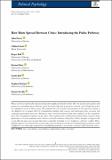Files in this item
How riots spread between cities : introducing the ‘police pathway’
Item metadata
| dc.contributor.author | Drury, John | |
| dc.contributor.author | Stott, Clifford | |
| dc.contributor.author | Ball, Roger | |
| dc.contributor.author | Barr, Dermot | |
| dc.contributor.author | Bell, Linda | |
| dc.contributor.author | Reicher, Stephen | |
| dc.contributor.author | Neville, Fergus | |
| dc.date.accessioned | 2021-10-13T14:30:03Z | |
| dc.date.available | 2021-10-13T14:30:03Z | |
| dc.date.issued | 2021-10-12 | |
| dc.identifier | 275065329 | |
| dc.identifier | 4409b610-9203-465f-b242-16870da0ced4 | |
| dc.identifier | 85116879879 | |
| dc.identifier | 000715211200001 | |
| dc.identifier.citation | Drury , J , Stott , C , Ball , R , Barr , D , Bell , L , Reicher , S & Neville , F 2021 , ' How riots spread between cities : introducing the ‘police pathway’ ' , Political Psychology , vol. Early View . https://doi.org/10.1111/pops.12786 | en |
| dc.identifier.issn | 0162-895X | |
| dc.identifier.other | ORCID: /0000-0001-7377-4507/work/101581553 | |
| dc.identifier.uri | https://hdl.handle.net/10023/24130 | |
| dc.description | Economic and Social Research Council. Grant Number: ES/N01068X/1. | en |
| dc.description.abstract | Waves of riots are politically and psychologically significant national events. The role of police perceptions and practices in spreading unrest between cities has been neglected in previous research, even though the police are significant actors in these events. We examined the role of police interventions in the spread of rioting to one English city in August 2011 by triangulating multiple data sources and analyzing police accounts and community-participant interviews. Rioting in other cities had relatively little direct influence in the community, but it led to heightened vigilance in the police. The resultant police mobilization inadvertently created a large gathering in a local community with a history of hostile relations with police. Police attempts to disperse the crowd affected many more people than those originally intending to riot, leading to collective conflict. These findings support a new theoretical account of the role of policing in riot spread. Complementing existing accounts of diffusion, our study helps explain how self-fulfilling prophecy can operate to spread conflict between cities. | |
| dc.format.extent | 19 | |
| dc.format.extent | 127549 | |
| dc.language.iso | eng | |
| dc.relation.ispartof | Political Psychology | en |
| dc.subject | Riots | en |
| dc.subject | Social identity | en |
| dc.subject | Social influence | en |
| dc.subject | Empowerment | en |
| dc.subject | Police | en |
| dc.subject | Civil unrest | en |
| dc.subject | BF Psychology | en |
| dc.subject | 3rd-DAS | en |
| dc.subject.lcc | BF | en |
| dc.title | How riots spread between cities : introducing the ‘police pathway’ | en |
| dc.type | Journal article | en |
| dc.contributor.sponsor | Economic & Social Research Council | en |
| dc.contributor.institution | University of St Andrews. School of Psychology and Neuroscience | en |
| dc.contributor.institution | University of St Andrews. School of Management | en |
| dc.identifier.doi | https://doi.org/10.1111/pops.12786 | |
| dc.description.status | Peer reviewed | en |
| dc.date.embargoedUntil | 2021-10-12 | |
| dc.identifier.grantnumber | ES/N01068X/1 | en |
This item appears in the following Collection(s)
Items in the St Andrews Research Repository are protected by copyright, with all rights reserved, unless otherwise indicated.

